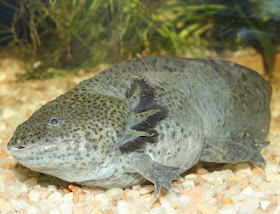The axolotl, Ambystoma mexicanum, is the best known of the Mexican neotenic mole salamanders belonging to the Tiger Salamander complex. Larvae of this species fail to undergo metamorphosis, so the adults remain aquatic and gilled.
Axolotls are used extensively in scientific research due to their ability to regenerate most body parts, ease of breeding, and large embryos.
 As of 2008, wild axolotls are near extinction due to urbanization in Mexico City and polluted waters and are listed by CITES as an endangered species.
As of 2008, wild axolotls are near extinction due to urbanization in Mexico City and polluted waters and are listed by CITES as an endangered species.A sexually mature adult axolotl, at age 18-24 months, ranges in length from 15–45 centimetres (5.9–18 in), although a size close to 23 centimetres (9.1 in) is most common and greater than 30 centimetres (12 in) is rare.
 Their limbs are underdeveloped and possess long, thin digits.
Their limbs are underdeveloped and possess long, thin digits.Three pairs of external gill stalks (rami) originate behind their heads and are used to move oxygenated water.
Axolotls have four different colours, two naturally occurring colours and two mutants. The two naturally occurring colours are wildtype (varying shades of brown usually with spots) and melanoid (black). The two mutant colours are leucistic (pale pink with black eyes) and albino (golden, tan or pale pink with pink eyes).
